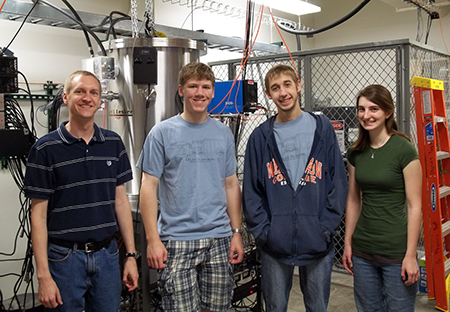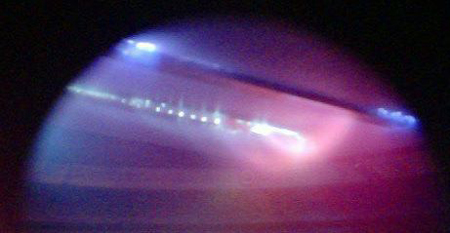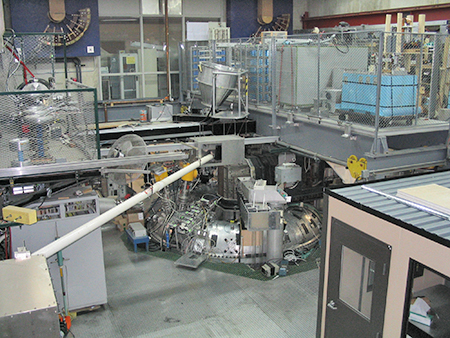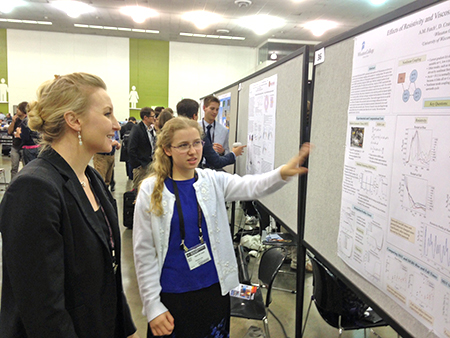Dr. Darren Craig’s research group studies plasmas in two different experiments. One experiment (WIRX) is located at Wheaton College and was built in collaboration with students. The other (MST) is located at the University of Wisconsin – Madison.
The Wheaton Impulsive Reconnection eXperiment (WIRX)
In the WIRX experiment we make pulsed hydrogen plasmas in the shape of an arcade. A high voltage is applied between two copper electrodes and a discharge is made with a current of several kiloamps running through the plasma. The current heats the plasma by Ohmic heating, in a similar fashion to the heating of a toaster or electric stove element. Plasmas can be shaped and contained by magnetic fields. In WIRX, the arcade-shaped discharge is produced by adding a magnetic coil that wraps around the electrodes in a figure eight pattern. This creates a magnetic field pointing out of one electrode and into the other.
 (Photo: WIRX experiment with Dr. Darren Craig and three students, Matthew McMillan, Cole Adams, and Mindy Cartolano.)
(Photo: WIRX experiment with Dr. Darren Craig and three students, Matthew McMillan, Cole Adams, and Mindy Cartolano.)
Depending on the amount of current driven in the discharge, the plasma arcade will expand and the magnetic field geometry will be altered by the behavior of the plasma. Magnetic reconnection is one possible process that can occur during this reconfiguration of the magnetic field. Reconnection allows magnetic energy to be dissipated and plasma energy (either thermal energy or kinetic energy) to be generated. This process is important in many astrophysical settings and in other laboratory plasmas as well. For example, reconnection plays an important role in solar flares and in magnetic storms in the earth’s magnetosphere. In WIRX our goal is to study the physics of impulsive (non-steady) reconnection in three dimensions.

Students have built most of the WIRX experiment. This includes design and construction of the electrodes and coil, high voltage power supplies, computer control and data acquisition systems, and custom diagnostics for measuring magnetic fields and emission from the plasma. Their work has contributed to a large number of conference presentations and several seniors have done their honors thesis on the WIRX project. A grant from the US Department of Energy provided funding for much of the construction as well as funds for two fast intensified CCD cameras that are used to image the plasma with exposure times as short as 5 ns.
(Photo: Image of a WIRX discharge.)

 Wheaton students have worked with Dr. Craig to better understand the characteristics and consequences of impulsive reconnection events that occur spontaneously in MST. Many of these studies have made use of fast spectroscopy as a diagnostic tool to study the behavior of the plasma ion flow and temperature. Students have also done Magnetohydrodynamic (MHD) simulations of the plasma to facilitate interpretation of the experimental measurements and to improve our understanding of the important physics. Students working on MST-related projects have presented at conferences and have published in Physics of Plasmas and Review of Scientific Instruments. Several students have also completed honors theses on MST projects.
Wheaton students have worked with Dr. Craig to better understand the characteristics and consequences of impulsive reconnection events that occur spontaneously in MST. Many of these studies have made use of fast spectroscopy as a diagnostic tool to study the behavior of the plasma ion flow and temperature. Students have also done Magnetohydrodynamic (MHD) simulations of the plasma to facilitate interpretation of the experimental measurements and to improve our understanding of the important physics. Students working on MST-related projects have presented at conferences and have published in Physics of Plasmas and Review of Scientific Instruments. Several students have also completed honors theses on MST projects.